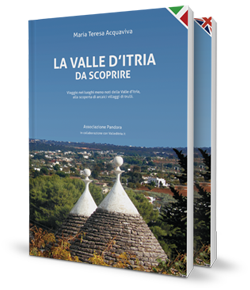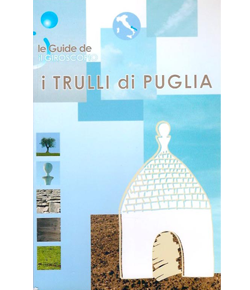Text translated by Google Translate.
In 2018, the art of making dry stone walls was declared by UNESCO Intangible Heritage of Humanity for the harmonious relationship it creates between man and nature.
Karst in Puglia is widespread from Gargano to Salento through the Murge plateau, with kilometers of dry stone walls that have designed a stone landscape for centuries. In the woods large layers of rock emerge and the soils are full of scattered stones which still constitute an obstacle for agricultural activity. The removal of the stones from the ground was a hard job that in the past centuries the peasants have done during the periods when they were not busy for the agricultural work.
The large and small stones were removed manually and accumulated in specchie, stony heaps which over time even reached considerable heights; many specchie have been raised with a generally circular perimeter wall and filled with stones in the center. If the rocky layer was very deep, the rock broke with the pickaxe and the work was long and tiring. With the mechanization of rural activities, the same work takes place today in a few hours with machines that grind stones. The stones accumulated in the specchie were reused for the construction of dry stone walls, which enclosed the properties and on the farms they also had e from the pastures. The courtyards of the animals, including the iazzi (stables for the goats), were enclosed in monumental dry stone with function of separating the arable land walls, the walls of which had a jutting frame against the assaults of wolves, foxes and cattle thieves. The courtyards enclosed by high walls also guaranteed labor savings for the custody of animals raised in a semi-wild state.
The dry technique, all over the world, is very primitive not only for dry stone walls, but also for buildings, such as the Apulian trulli. Looking at the section of an ancient drywall, the shape is that of an isosceles trapezoid, with the widest side on the ground and with an average height of 1.50 / 1.60 m, with the concave surface useful for letting flow rainwater in the wall. The height is sometimes equal to the width of the base on the ground. However, all these rules vary depending on the stone material available, compact or more porous, the time taken and the skill of the workforce. The road reorganization of the countryside in the last decades of the twentieth century caused the demolition of many original dry stone walls which were roughly rebuilt by institutions, Municipalities and Provinces, to a lesser extent both in height and thickness and less stable than their ancestors. In fact, the thickness of the original walls is considerable, since they consist of two blocks on each side, formed by large interlocking assembled stones and by an interspace full of small stones of various sizes, all without any type of mortar. Many walls built more recently no longer have that particular irregularity typical of limestone, but smooth walls because the stones are now industrially prepared and therefore smoothed. In the past, the master builder used to model stones with special tools to facilitate interlocking work. Today we continue to build dry stone walls, some are faithful to the ancient technique, many instead have smooth surfaces and large and wide stones that cover them, which make the water slide out of the wall, interrupting an important function of the building, which we will discuss later. Apparently in dry stone, some walls are built with a concrete core, a technique that allows you to save on maintenance costs but definitively cancels all the functions that dry stone walls perform for eco-sustainability.
Dry stone walls and their importance for the ecosystem.
The steeper hills of the Murgia dei Trulli are terraced with the help of dry stone walls which have the fundamental function of curbing, or at least limiting, the erosion of the soil due to heavy rains, also limiting the salification of the soil which leads to gradual desertification. The dry stone walls also attenuate the action of the wind on the newly sown soils, preventing the seeds from flying and accumulating in a discontinuous way, attenuating the action of the wind on the leaves of the trees, not stripping them. A tree with few leaves limits the shade of the soil in the hot summer hours with consequent evaporation of the water contained in the soil, indispensable water for vegetation. Speaking of water, during the hot and dry season, stone walls collect water daily through the condensation of water vapor contained in the air. That steam in the hot hours penetrates the meanders of the rocks outcropping on the ground and between the interstices of the dry stone walls. After sunset, the night cooling begins and the tiny droplets condense among the stones and slowly descend on the ground which absorbs the water until saturation. That water from the ground is redistributed to the plants. When uprooting trees in land enclosed by dry stone walls, it is easy to recognize a greater orientation of the roots of the plant in the direction of the walls of the fence. It should be added that the water accumulated at night in the ground under the wall does not evaporate during the day, protected by the wall itself. So dry stone walls are water accumulators that redistribute to the ground. The same functions have the agricultural specchie, the piles of stones, because they create a microclimate conducive to the growth of Mediterranean plants that manage to survive long periods of drought.
Walking among the numerous tratturi ( rural grassy paths) of the Valle d'Itria and crossing the asphalted rural roads you can see, near the dry stone walls, brambles, needle-like plants such as thyme, small lentisk and oak bushes, asparagus and numerous herbs, to name only a few. A fertile substrate develops in the cracks of the stones thanks to the action of mosses and lichens which the higher plants feed on. The interstices of the stones also become a safe home for a variety of insects, even small reptiles and amphibians that feed on many parasites, performing an essential function for agriculture. Some old dry stone walls offer hospitality to sparrows' nests when they are covered with ivy leaves, which hide life inside.
The dry stone walls in Puglia embrace a very wide cultural sphere, not only that linked to the most recent agricultural colonization. On the Murgia dei Trulli between Ceglie Messapica, Villa Castelli and Martina Franca, traces of remote Paretoni are preserved, that is, monumental dry walls that reach a width of even four / five meters, which in remote times constituted territorial limits. A Paretone was to be the Byzantine limes which in the Middle Ages in Puglia separated the Byzantine borders from the Lombard ones. Perhaps it is the same paretone that popular tradition claims was built in one night by the magician Virgil, the great poet, in this case, in the role of tutelary deity.
In 2018 finally the art of dry stone walls was recognized by UNESCO as an Intangible Heritage of Humanity for the harmonious relationship between man and nature. This recognition was obtained because some European and Mediterranean countries, including Italy, had submitted their candidacy. Intangible heritage such as religious holidays, popular beliefs, dances and popular music of a place. It could be said that they are stone books that tell centuries of stories full of efforts, sweat, prayers, difficulties and joys, therefore walls that are custodians of memories. In Puglia they represent the tenacity with which the peasant civilization has dialogued with an apparently hostile land.


















